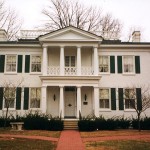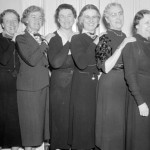In 1938, the Republican Party was in disarray—both nationally and in the state of Indiana. On the national level, FDR and his fellow Democrats had won massive victories in the 1936 election, and the New Deal was further concentrating federal power.
Some pundits even wondered if the GOP was in fact on its deathbed: “[s]o badly were Republicans shaken by the election that the editors of Fortune suggested that the party go out of existence.” At the state level, Paul V. McNutt had served as a strong Democratic governor since 1933, and “the Republican rank-and-file was apathetic.”
Into this sad state of affairs came Homer E. Capehart, who had risen from Pike County farm boy with a high school education to millionaire manufacturer and salesman of Wurlitzer jukeboxes—during the Great Depression years. Capehart credited his success to hard work, individual self-discipline, and an optimistic attitude, and he felt that both the Republican Party and the American nation needed a good dose of those qualities to lift them out of the doldrums.
In February 1938, Capehart went to Arch Bobbitt, state chair of the Republican Party, with a proposal. The previous year, Capehart had organized and held a large company picnic for Wurlitzer salesmen and their families on his own farm in Daviess County. Now Capehart proposed a “mid-term Republican conference” in August along the same lines: “a cornfield rally.”
Bobbitt knew that his party workers were discouraged, and he had been looking for some way to bring together precinct committee leaders statewide. He agreed to Capehart’s offer to host “a clambake on my farm”.
On August 27, 1938, the farm was ready. “Twenty-eight blue and white striped tents were arranged . . . on a 120 acre freshly mowed alfalfa field” . One large tent held ten thousand people seated at tables; other tents held each of the twelve Indiana delegations, kitchens, radio broadcasters, the press, first aid stations, and soft drink concessions.
In all, twenty thousand precinct committeemen, county chairmen, their families, and dignitaries from out of state attended the “Cornfield Conference,” filling nearby fields with thousands of cars. Special trains arrived from all over Indiana and as far away as New York, carrying more visitors.
“Cooks and waiters were at work steaming clams and barbecuing chickens over huge charcoal pits in the four kitchen tents”. The tables were “filled with barbecued chicken, relishes, mashed potatoes and country gravy, corn on the cob, watermelon, rolls and butter, iced tea, and coffee.” Guests consumed “more than five thousand chickens, seventy thousand steamed clams, and three tons of corn on the cob.”
The rally also offered a variety of entertainments: guests could “see a real Indian chief, watch stuntmen, and listen to yodelers, guitar players, a German band, the Wurlitzer Military Band, and thirty-two individual drum and bugle corps from the surrounding area” .
Capehart oversaw the epic event and checked every detail. Dressed in “floppy canvas sun hat, white long sleeved shirt, long checked tie, tan cotton trousers, and cigar in the corner of his mouth,” Capehart greeted everyone with a warm handshake.
The Cornfield Conference was a success, making the front pages of The New York Times, The Chicago Tribune and countless other papers. Capehart had made his political name, and his fellow Republicans were grateful. He went on to serve Indiana in the United States Senate from 1944 to 1963.
A Moment of Indiana History is a production of WFIU Public Radio in partnership with the Indiana Public Broadcasting Stations. Research support comes from Indiana Magazine of History published by the Indiana University Department of History.
IMH Source Article: William B. Pickett, “The Capehart Cornfield Conference and the Election of 1938: Homer E. Capehart’s Entry into Politics,” Indiana Magazine of History 73, no. 4 (Dec. 1977): 251-275.
Other source: Biographical Directory of the United States Congress.






















